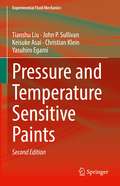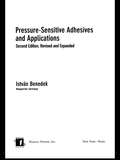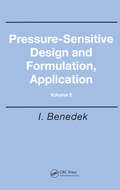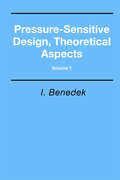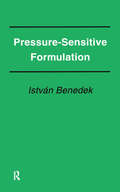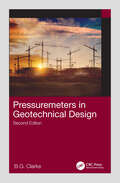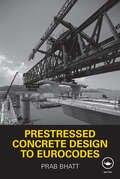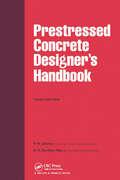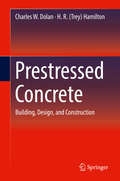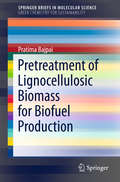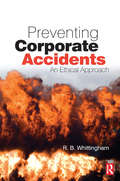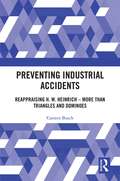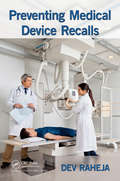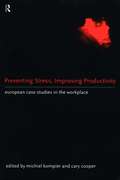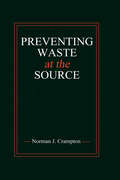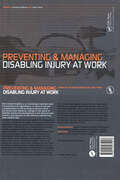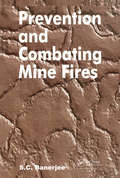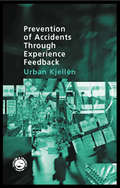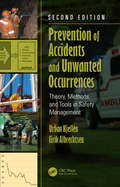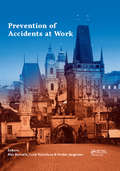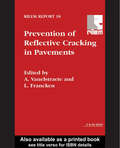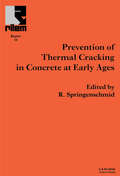- Table View
- List View
Pressure and Temperature Sensitive Paints (Experimental Fluid Mechanics)
by Christian Klein John P. Sullivan Tianshu Liu Keisuke Asai Yasuhiro EgamiThis new edition describes pressure and temperature sensitive paints (PSP and TSP) in global surface pressure and temperature measurements in aerodynamics and fluid mechanics. The book includes the latest progress in paint formulations, instrumentation, and steady and unsteady aerodynamic measurements in various facilities including low-speed, transonic, supersonic and hypersonic wind tunnels. The updated technical aspects of PSP and TSP in the book will be useful for students and researchers in experimental aerodynamics and fluid mechanics.
Pressure-Sensitive Adhesives and Applications (Handbook Of Pressure-sensitive Adhesives And Products Ser.)
by Istvan BenedekPressure-Sensitive Adhesives and Applications, Second Edition explains how pressure-sensitive adhesives (PSAs) work, why they are used, and the technology used to manufacture them. This second edition features the latest developments in the field.Dr. Benedek discusses the factors that affect the rheology and special flow characteristics res
Pressure-Sensitive Design and Formulation, Application
by Istvan BenedekGrowing interest in the formulation of pressure-sensitive adhesives as described in the first edition of this book ( Pressure-Sensitive Formulation, VSP, 2000) required a new, enlarged edition including the design of pressure-sensitive adhesives as a separate volume. Developments in the understanding of pressure sensitivity were necessary to use ma
Pressure-Sensitive Design, Theoretical Aspects
by Istvan BenedekGrowing interest in the formulation of pressure-sensitive adhesives as described in the first edition of this book ( Pressure-Sensitive Formulation, VSP, 2000) required a new, enlarged edition including the design of pressure-sensitive adhesives as a separate volume. Developments in the understanding of pressure sensitivity were necessary to use ma
Pressure-Sensitive Formulation
by Istvan BenedekGrowing interest in the formulation of pressure-sensitive adhesives as described in the first edition of this book ( Pressure-Sensitive Formulation, VSP, 2000) required a new, enlarged edition including the design of pressure-sensitive adhesives as a separate volume. Developments in the understanding of pressure sensitivity were necessary to use macromolecular chemistry for pressure-sensitive design. Such developments include polymer physics and contact mechanics. Progress in coating technology, especially in in-line coating- and synthesis, opened new ways for the design of pressure-sensitive adhesives and products as well. Actually, pressure-sensitive-products with and without adhesives compete requiring a broad variety of material formulations and the corresponding manufacturing technology. The first volume of the book examines the theoretical aspects of pressure-sensitive design, based on macromolecular chemistry, macromolecular physics, rheology and contact mechanics. The second volume describes the practical aspects of pressure-sensitive design and formulation, related to product application. The advances in the various domains are described by specialists.
Pressuremeters in Geotechnical Design
by B.G. ClarkeThe pressuremeter is a versatile piece of ground investigation equipment that can be used to test any type of soil or rock in situ. It quantifies in-situ stress, stiffness, strength and permeability – the essential properties needed to design geotechnical structures. The results are used in pressuremeter specific design methods, empirical design methods and numerical analyses. This reference book covers the types of pressuremeter and the control equipment, methods of installation, test procedures, methods of analysis including direct and indirect methods of interpretation, and application in design. This is supported by an exemplar specification for field operations with the interpretation of the results. Engineers are given enough detail to apply the results confidently. This comprehensive and thorough discussion of pressuremeter testing in geotechnical design draws on over forty years’ experience in geotechnical engineering. It is essential for professional and academic engineering geologists and geotechnical, civil and structural engineers involved in ground investigation and geotechnical design.
Prestressed Concrete Design to Eurocodes
by Prab BhattOrdinary concrete is strong in compression but weak in tension. Even reinforced concrete, where steel bars are used to take up the tension that the concrete cannot resist, is prone to cracking and corrosion under low loads. Prestressed concrete is highly resistant to stress, and is used as a building material for bridges, tanks, shell roofs, floors
Prestressed Concrete Designer's Handbook
by P.W. Abeles B K Bardhan-RoyThe third edition of this authoritative handbook provides the structural designer with comprehensive guidance on prestressed concrete and its effective use, covering materials, behaviour, analysis and design of prestressed elements. It includes numerous examples, design charts and details of post-tensioning systems.
Prestressed Concrete: Building, Design, and Construction
by Charles W. Dolan H. R. HamiltonThis textbook imparts a firm understanding of the behavior of prestressed concrete and how it relates to design based on the 2014 ACI Building Code. It presents the fundamental behavior of prestressed concrete and then adapts this to the design of structures. The book focuses on prestressed concrete members including slabs, beams, and axially loaded members and provides computational examples to support current design practice along with practical information related to details and construction with prestressed concrete. It illustrates concepts and calculations with Mathcad and EXCEL worksheets. Written with both lucid instructional presentation as well as comprehensive, rigorous detail, the book is ideal for both students in graduate-level courses as well as practicing engineers.
Pretreatment of Lignocellulosic Biomass for Biofuel Production
by Pratima BajpaiThe book describes the pretreatment of lignocellulosic biomassfor biomass-to-biofuel conversion processes, which is an important step inincreasing ethanol production for biofuels. It also highlights the mainchallenges and suggests possible ways to make these technologies feasible for the biofuel industry. Thebiological conversion of cellulosic biomass into bioethanol is based on thechemical and biological breakdown of biomass into aqueous sugars, for exampleusing hydrolytic enzymes. The fermentable sugars can then be further processedinto ethanol or other advanced biofuels. Pretreatment is required to break downthe lignin structure and disrupt the crystalline structure of cellulose so thatthe acids or enzymes can easily access and hydrolyze the cellulose. Pre-treatment can be the most expensive process in converting biomass to fuel,but there is great potential for improving the efficiency and lowering coststhrough further research and development. This book is aimed at academics andindustrial practitioners who are interested in the higher production of ethanolfor biofuels.
Preventing Corporate Accidents: An Ethical Approach
by R B WhittinghamThe passing of the Corporate Manslaughter and Corporate Homicide Bill in the UK and increasing public and investor pressure for good Corporate Governance and Corporate Social Responsibility, means organizations now, more than ever, need to ensure they do all they can to prevent major accidents. However, past experience shows that just implementing safety management systems is not enough and this book makes the case for a more holistic and ethical approach to improving corporate systems as a whole.Preventing Corporate Accidents shows how major accidents can result from human error and defects in corporate systems. The book describes accident prevention strategies, from safety culture, safety management systems, foresight and planning to safety regulations, corporate ethics, corporate social responsibility and the learning organization. Barry Whittingham illustrates with international case studies from various industries how and why these defences have failed in the past, and more importantly, how to strengthen corporate systems to prevent future major accidents.The case studies include: The loss of the space shuttle ColumbiaInfant heart surgery at Bristol Royal InfirmaryThe Davis-Besse nuclear power plant incidentThe fire and explosion at the Conoco-Phillips Humber oil refineryHerald of Free Enterprise and Southall rail accident manslaughter prosecutionsThis book is essential reading for all those with a professional interest in health and safety management, the control of major risk and accident prevention, in particular for directors, senior managers and health & safety professionals in high-hazard industries and public operations, such as nuclear, chemicals, construction, oil and gas, energy, manufacturing and transportation.Barry Whittingham has worked as a senior manager, design engineer and consultant for the chemical, nuclear, offshore, oil and gas, railway and aviation sectors. He developed a career as a safety consultant specializing in the human factors aspects of accident causation. Barry is a Fellow of the Safety and Reliability Society.
Preventing Industrial Accidents: Reappraising H. W. Heinrich – More than Triangles and Dominoes
by Carsten BuschHerbert William Heinrich has been one of the most influential safety pioneers. His work from the 1930s/1940s affects much of what is done in safety today – for better and worse. Heinrich’s work is debated and heavily critiqued by some, while others defend it with zeal. Interestingly, few people who discuss the ideas have ever read his work or looked into its backgrounds; most do so based on hearsay, secondary sources, or mere opinion. One reason for this is that Heinrich’s work has been out of print for decades: it is notoriously hard to find, and quality biographical information is hard to get. Based on some serious "safety archaeology," which provided access to many of Heinrich’s original papers, books, and rather rich biographical information, this book aims to fill this gap. It deals with the life and work of Heinrich, the context he worked in, and his influences and legacy. The book defines the main themes in Heinrich’s work and discusses them, paying attention to their origins, the developments that came from them, interpretations and attributions, and the critiques that they may have attracted over the years. This includes such well-known ideas and metaphor as the accident triangle, the accident sequence (dominoes), the hidden cost of accidents, the human element, and management responsibility. This book is the first to deal with the work and legacy of Heinrich as a whole, based on a unique richness of material and approaching the matter from several (new) angles. It also reflects on Heinrich’s relevance for today’s safety science and practice.
Preventing Medical Device Recalls
by Dev RahejaA critical and often overlooked aspect of preventing medical device recalls is the ability to implement systems thinking. Although systems thinking won‘t prevent every mistake, it remains one of the most effective tools for evaluating hidden risks and discovering robust solutions for eliminating those risks.Based on the author‘s extensive experienc
Preventing Stress, Improving Productivity: European Case-Studies in the Workplace
by Cary Cooper Michiel KompierIn a representative study made of European workers, twenty-eight per cent of employees reported that stress affects their health and their performance at work. Occupational stress is a serious problem for the performance of individuals, organisations and as a consequence, for national economies. Preventing Stress, Improving Productivity investigates the ways in which companies can combat stress by changing the working environment rather than only treating individual employees with stress symptoms.Costs and benefits of stress prevention are discussed, with an emphasis on appraoches that involve both the work situation and the individual worker. The heart of the book consists of eleven European country chapters, each overviewing the current status with respect to occupational stress and its prevention in that country and then presenting one detailed case study an example of good preventive practice. Preventing Stress, Improving Productivity identifies five factors that are critical for a stress reduction programme to work, both in terms of employee health and well-being and from a financial point of view. Successful strategies combine participation from workers and support from top management. Useful as a reference for psychologists, human resource managers, occupational physicians, ergonomists and consultants, this book will also be an invaluable aid to managers in the day-to-day running of organisations.
Preventing Waste at the Source
by Norman J. CramptonAfter a day's work is finished, take a look around at your company. Do standard production processes and day-to-day operations leave you with loaded trash bins from the front office to the factory floor-and every place inbetween?Such "solid waste" does far more than squander resources and imperil the environment... it's undoubtedly eating up countless dollars of your profits.Corporations throughout the nation are learning to tame solid waste, by implementing improved management of materials. Preventing Waste at the Source demonstrates how more than 50 companies have effectively reduced solid waste throughout all departments-and achieved dramatic reductions in operating costs.Beginning with a strategic framework, readers can then zero in on wasteful practices affecting all aspects of a business. Paper reduction measures for administrative offices, for instance. Ways to minimize packing materials over in the shipping department, while still protecting the product. There's also steps where suppliers and customers can take part in waste minimization efforts. Case histories prove it can be done, to everyone's advantage.Researched and compiled by the Indiana Institute on Recycling, Preventing Waste at the Source offers practical, on-the-job assistance to environmental managers, plant managers, manufacturing and quality engineers. Put its techniques and real-life guidance to work. You'll save more than money: you'll help save the environment.
Preventing Workplace Incidents in Construction: Data Mining and Analytics Applications (Spon Research)
by Imriyas KamardeenThe construction industry is vital to any national economy; it is also one of the industries most susceptible to workplace incidents. The unacceptably high rates of incidents in construction have huge socio-economic consequences for the victims, their families and friends, co-workers, employers and society at large. Construction safety researchers have introduced numerous strategies, models and tools through scientific inquiries involving primary data collection and analyses. While these efforts are commendable, there is a huge potential to create new knowledge and predictive models to improve construction safety by utilising already existing data about workplace incidents. In this new book, Imriyas Kamardeen argues that more sophisticated approaches need to be deployed to enable improved analyses of incident data sets and the extraction of more valuable insights, patterns and knowledge to prevent work injuries and illnesses. The book aims to apply data mining and analytic techniques to past workplace incident data to discover patterns that facilitate the development of innovative models and strategies, thereby improving work health, safety and well-being in construction, and curtailing the high rate of incidents. It is essential reading for researchers and professionals in construction, health and safety and anyone interested in data analytics.
Preventing and Managing Disabling Injury at Work
by John Frank Terrence SullivanThis unique reference reveals what works best in preventing workplace disability. Preventing and Managing Disabling Injury at Work examines the changing nature of the workplace and work force and includes recent information on effective early and staged multi-modal interventions in the workplace. The text also explores psychological risk perception and the essential linking of the workplace, clinician, insurer, and worker in the recovery process and in the prevention of subsequent disability events. Well-illustrated with case studies and practical examples, much of the book focuses on the common musculoskeletal disabilities and regional disorders along with other, broader applications.
Prevention and Combating Mine Fires
by Sudhish Chandra BanerjeeThere is a growing concern about fires in mines, coal mines in particular. Attempts are being made to improve mine fire combat efforts and their prevention, taking advantage of developments in the fields of science and technology. This book looks at those developments and their applications.
Prevention of Accidents Through Experience Feedback
by Urban KjellenProviding a practical introduction to the basic theories and principals of accident prevention through diagnosis and feedback control, this book presents the various methods and tools of safety, health, and environment (SHE) practice where experience feedback is employed. These include methods of accident and near accident reporting and investigati
Prevention of Accidents and Unwanted Occurrences: Theory, Methods, and Tools in Safety Management, Second Edition
by Urban Kjellen Eirik AlbrechtsenThis new edition comes after about 15 years of development in the field of safety science and practice. The book addresses the question of how to improve risk assessments, investigations, and organizational learning inside companies in order to prevent unwanted occurrences. The book helps the reader in analyzing the subject from different scientific perspectives to demonstrate how they contribute to an overall understanding. It also gives a comprehensive overview of different methods and tools for use in safety practice and helps the reader in analyzing their scope, merits, and shortcomings. The book raises a number of critical issues to be addressed in the improvement process.
Prevention of Accidents at Work: Proceedings of the 9th International Conference on the Prevention of Accidents at Work (WOS 2017), October 3-6, 2017, Prague, Czech Republic
by Ales Bernatik Lucie Kocurkova Kirsten JørgensenPrevention of Accidents at Work collects papers presented at the 9th International Conference on the Prevention of Accidents at Work (WOS 2017) held in Prague, Czech Republic, on October 3-6, 2017, organized by the VSB-Technical University of Ostrava. The conference on current issues within occupational safety is organized under the umbrella of Workingonsafety.net (WOS.net). WOS.net is an international network of decision-makers, researchers and professionals responsible for the prevention of accidents and trauma at work. The network aims to bring accident prevention experts together in order to facilitate the exchange of experience, new findings and best practices between different countries and sectors. WOS.net is supported by the European Agency for Safety and Health at Work (EU-OSHA).The overall theme is safety management complexity in a changing society, with the motto: Do we need a holistic approach? Underlying topics include: Foundations of safety science: theories, principles, methods and tools; Research to practice: achievements, lessons learned and challenges; Risk management and safety culture: case studies, best practices and further needs; Safety regulation: reasonable practicable approach; Education and training: prerequisite for safety; Complexity and safety: multidisciplinarity and inter-stakeholder views. Prevention of Accidents at Work should be valuable to researchers, policy makers, safety professionals, labor inspectors, labor administrators and other experts in the prevention of occupational accidents.
Prevention of Air Pollution: Selected Paper in 2024 9th International Conference on Advances in Energy and Environment Research (Environmental Science and Engineering)
by Qiang Wang Ahmad Hosseini-BandegharaeiThis book offers readers with analysis of the main causes and purification technology of air pollution.Air, as the primary element on which human life depends, directly impacts human living and health. However, a 2022 report from the World Health Organization indicated that "the air nearly the entire global population (99%) breathes exceeds WHO air quality limits, threatening their health". Currently, the main approaches to air pollution involve source control and the treatment of air pollutants.Analyzing the causes of air pollution is an effective method for controlling pollution from its source and preventing its spread. It is also an efficient and rapid way to identify harmful gas components and then apply targeted treatment.Currently, big data model analysis and sensor perception technology are widely used analytical techniques. Combined with chemical transport models, they can simulate and predict pollutants, achieving better causal analysis and forecasting.Additionally, air pollution purification is an important component of prevention of air pollution.Currently, the most important research direction is how to purify air pollution without causing secondary environmental contamination, in addition to physical and chemical means.This book provides engineers and researchers in the field of air pollution prevention with research findings related to this area. It aims to share specific and valuable knowledge and content to improve prevention of air pollution efforts.
Prevention of Premature Staining in New Buildings
by Phil ParnhamThe appearance of ugly staining early in a buildings life, ruins an otherwise pleasing appearance, tarnishes the image of the owners and gives rise to costly refurbishment works. In this book Phil Parnham raises a number of questions that should be considered whenever a new building is being designed or built. These are: * why has staining become so prominent; * what causes premature staining; which parts of new buildings are likely to be affected; * how can it be avoided? By using a number of highly illustrated case studies, the author answers these questions and ends by suggesting measures that should be taken by all design and construction professionals to prevent premature staining.
Prevention of Reflective Cracking in Pavements
by A.Vanelstraete and L.FranckenCrack reflection through a road structure is one of the main causes of premature pavement deterioration. This is a widespread problem in many countries and highway maintenance authorities are having to find economic means of repairing and upgrading their pavements. This book is the eagerly awaited state-of-the-art report which considers all differe
Prevention of Thermal Cracking in Concrete at Early Ages
by R. SpringenschmidAn important new report from the RILEM Technical Committee 119. This book presents models and methods to determine thermal stresses and cracking risks in concrete. The possible influences on and causes of thermal cracking of concrete are discussed and cases of practical measures for avoiding cracking are detailed.
